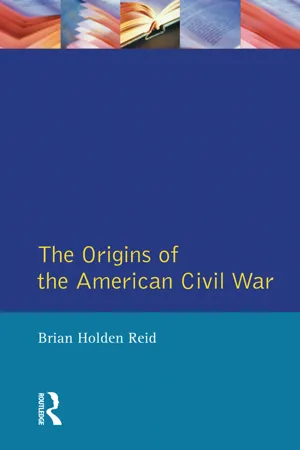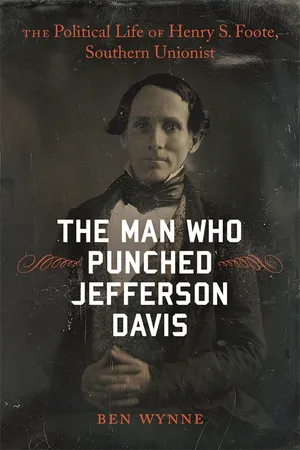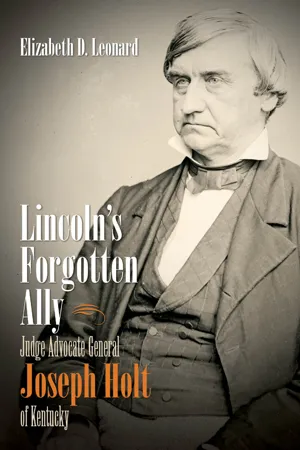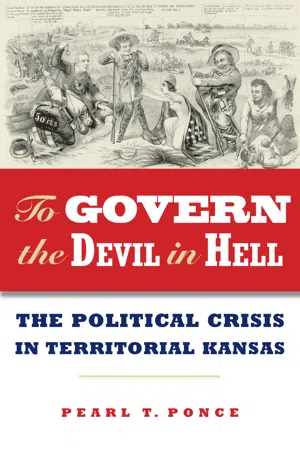History
Compromise of 1850
The Compromise of 1850 was a package of laws passed by the US Congress to address the issue of slavery in the newly acquired territories from the Mexican-American War. It included the admission of California as a free state, the organization of the territories of New Mexico and Utah without restrictions on slavery, the abolition of the slave trade in Washington D.C., and the Fugitive Slave Act.
Written by Perlego with AI-assistance
Related key terms
6 Key excerpts on "Compromise of 1850"
- eBook - ePub
- Brian Holden Reid(Author)
- 2014(Publication Date)
- Routledge(Publisher)
action – the decisions taken by politicians – which determine the chain of circumstances that result in war or peace.The Compromise of 1850
The confrontation culminating in the Compromise of 1850 was the most dangerous crisis confronting the Union since the Nullification Crisis, seventeen years before. It has been correctly identified as a ‘fruit’ of manifest destiny. The extension of American civilization across the continental heartland could serve only to resuscitate sectional strife. At bottom, this perennial and unavoidable conflict was paradoxical. As one historian has observed, ‘If the removal of sectional controversy opened the way to new expansion, expansion would, in its train, bring on a renewal of sectional controversy’. The issues under discussion, although they were expressed in drab and legalistic language, came to assume a graphic and ominous symbolic significance.26 In the opinion of various historians, the Compromise eventually arrived at should be judged an ‘Armistice’ and the process by which it was agreed, a forerunner (though successful, on this occasion) of the final crisis that followed a decade later. In Bruce Collins’s view ‘The crisis of 1850 was a dress rehearsal for the show-down of 1860–1. Many of the arguments were the same. Many of the participants were the same’.27 The focus of the discussion here should be, not how and why the political crisis developed in the way that it did, but rather, why the efforts at compromise were successful and, further, why civil war did not erupt ten years before the detonation of 1861?This significant sectional crisis grew out of the attempts to bring statehood to the immense patrimony seized after the Mexican War. In California this issue was especially urgent after the Gold Rush of 1849; that territory desired early admission to the Union as a ‘free’ state and had already advanced very far in organizing its own government unaided by federal agencies. President Zachary Taylor was anxious that, if this wish was not speedily attended to, California would declare her independence. The South demanded a new ‘slave’ state to balance this increase in the non-slave states. The threat of anarchy in the South West was given further point by the claim aggressively advanced by Texas to all the territory held by New Mexico, east of the Rio Grande, which included Santa Fé. The federal government denied this claim and the possibility presented itself of a bloody clash between federal troops and Texas volunteer forces. The threat of civil war was indeed very real and took a more substantial and menacing form than just politicians uttering windy threats at one another in Washington.28 - eBook - ePub
Liberty and Union
A Constitutional History of the United States, concise edition
- Edgar J. McManus, Tara Helfman(Authors)
- 2014(Publication Date)
- Routledge(Publisher)
The election of Taylor settled nothing about the status of slavery in the new territories. California and New Mexico remained unorganized, and pressure mounted on Congress to break the impasse. Antislavery groups demanded the prohibition of slavery, while the South closed ranks to oppose them. In January of 1849 Calhoun and a caucus of sixty-eight southern congressmen issued an ultimatum to the North. They demanded that the territories be kept open to slavery, that runaway slaves be returned to their owners, and that the flow of antislavery propaganda to the South cease. Southerners began to talk about seceding and forming a southern confederacy if their demands were not met. The hardening of attitudes raised the prospect that the Union might dissolve unless a political settlement could be arranged.The Compromise of 1850
No one was more alarmed by the threat to the Union than Henry Clay, who now used his matchless political skills to save it. No longer driven by fierce personal ambition, Clay threw himself wholeheartedly into an effort to avert the impending disaster. In January of 1850 he presented the Senate with a set of proposals for settling the differences between the North and South. First, he proposed admitting California to the Union as a free state in accordance with the wishes of the settlers. Second, the rest of the territory taken from Mexico would be organized without any restrictions on slavery. The status of slavery would be decided by the settlers themselves under the principle later called “popular sovereignty.” Third, the slave trade would be prohibited in the District of Columbia, a ban long sought by the North. Fourth, a strong fugitive slave law would be passed for the return of slaves who had escaped to the North.Clay’s proposals brought on the greatest debate in the history of Congress. Although weakened by age and needing assistance to climb the steps of the Capitol, he argued for his compromise with great force and skill. Clay spoke for two days, and his theme was conciliation and moderation for the sake of the Union. To the North, he offered California as a free state, plus his assurance that the rest of the territory ceded by Mexico would almost certainly be free. Climate and geography made an explicit prohibition of slavery unnecessary. The compromise would also achieve the northern goal of ending the slave trade in the nation’s capital. To the South, Clay offered a more effective fugitive slave law and the organization of the Utah and New Mexico territories with no restrictions on slavery. While the compromise might not be perfect, it might be the last chance to save the Union. - eBook - ePub
The Man Who Punched Jefferson Davis
The Political Life of Henry S. Foote, Southern Unionist
- Ben Wynne(Author)
- 2018(Publication Date)
- LSU Press(Publisher)
“Taken together, in combination, they propose an amicable arrangement of all questions in controversy between the free and the slave states.” Everyone in the room—senators, staff and spectators, northerners and southerners—knew that Clay’s actions represented the beginning of a substantive and monumental discussion about the future of the United States. As Clay finished, an electric atmosphere prevailed in the capitol, with one newspaperman from Baltimore describing the proceedings as “one of the glorious days of the Senate.” In the end, of course, the compromise that Congress cobbled together during the period did not create a lasting peace and only postponed the inevitable. 8 By 1850, it was almost impossible to find common ground between politicians from the slaveholding states and those from the free states. The process of passing laws slowed almost to a halt as southerners circled the wagons in defense of slavery and some northerners began pressing an abolitionist agenda. While it seemed that every significant piece of legislation before Congress was tied in one way or another to the slavery debate, there were only a few foundational issues that were the greatest impediment to progress. These involved the status and statehood of California, the organization of remaining territory that had been part of the Mexican Cession, the boundaries of Texas, the status of slavery in the District of Columbia, and whether Congress would create a stronger fugitive slave law. The seventy-two-year-old Clay hoped his compromise plan would settle all of these issues - eBook - ePub
Lincoln's Forgotten Ally
Judge Advocate General Joseph Holt of Kentucky
- Elizabeth D. Leonard(Author)
- 2011(Publication Date)
- The University of North Carolina Press(Publisher)
Initially proposed by the elderly and declining Henry Clay, the Compromise of 1850 was ultimately shepherded to passage in the fall of that year by Illinois’s Democratic senator, Stephen Douglas. The compromise was designed to ease growing tensions between the slave and free states by offering complex concessions to both, the most important and controversial being a newly strengthened fugitive slave law that instituted stern fines for law enforcement officials—including U.S. marshals, state militia members, and federal troops—who did not arrest suspected runaways. The compromise also established fines for individuals who aided the runaways in any way, as well as rewards for those who helped to effect captures. Certainly no aspect of the Compromise of 1850 produced more heated discussion both within Congress and beyond its walls. Antislavery activists demanded the passage, at the state level, of “personal liberty laws” that would essentially nullify the Fugitive Slave Act, and slavery supporters angrily revisited the possibility of withdrawal from the Union if the Fugitive Slave Act, and what they insisted were their constitutional rights to own other human beings, were not protected.In the fall of 1850, from his vantage point in central Mississippi, thirty-five-year-old Robert Holt concluded that those Southern slaveholders who were once again threatening secession from the United States constituted “a treasonable movement” that must be taken seriously. Describing the “revolutionary condition” he saw developing across the South, Robert pointed to the large number of people in the region whose loyalty to the Union and the Constitution had begun to give way to grave discontent and, in some cases, “fierce and defiant hostility.” These fanatics, among whom Robert included Uncles Bob and Daniel Stephens, actively pondered not only secession and disunion but also the possibility of armed resistance to the federal government. Some, he reported, had already moved beyond just talking about their plans and were now organizing themselves for action through conventions, committees of correspondence, and other channels. Indeed, the Compromise of 1850 had failed completely to ease the tensions between the slave and free states. Rather, Robert wrote, it had “heated the furnace of Southern Passion several times hotter than before.” At the same time, although people in the northern states seemed calm, he suspected that they had a deeper, hidden purpose to carry “to yet greater extremes the policy by which the South has become so incensed,” namely, abolitionism. Robert predicted that the national political parties would soon collapse, and that this would be followed by the collapse of the Union in three years or less. Where in the world, he wondered, would the developing crisis lead? “Whether southern chivalry will hereafter condescend to cool its mint juleps with northern ice,” he mused, “has not been settled.” For his part, Robert—like Holt—remained pledged to the Union, so much so, in fact, that he decided to pull up stakes in May 1851 and move his family from slaveholding Mississippi to free Cincinnati, just across the Ohio River from Covington, Kentucky, and about a hundred miles from Louisville. Falling back on a habit of many years’ duration, Robert asked his brother for a loan to help him get his new residence in order, his twenty-seven acres of land under cultivation, and his legal practice up and running. Holt sent him $600.59 - eBook - ePub
Journal of the Civil War Era
Spring 2014 Issue
- William A. Blair(Author)
- 2014(Publication Date)
- The University of North Carolina Press(Publisher)
Because Clay had so intimately wrapped this method of compromise around himself, his death in 1852 dealt the country a great blow. Americans believed him uniquely capable of convincing each side—antislavery and proslavery—to make concessions, while forcing neither to give up its principles. The very association between Clay and compromise that aided him in life made it extremely difficult, if not impossible, for another American leader to emerge as the next Great Compromiser after his death. Of course, as David Potter suggests, from 1820 to 1850 Americans had become more divided over the slavery issue and less willing to compromise, despite even the best efforts of their celebrated Kentuckian statesman. Potter points to Clay’s overoptimistic faith in compromise in 1850, noting that the senator “depended upon the existence of a majority in favor of compromise, and hence lumped the several measures together to buttress one another and to make the issue one of compromise in general.” Douglas, however, “was astute enough to recognize that there was no workable majority in favor of compromise” and separately navigated each act of the Compromise of 1850 through Congress.Douglas understood in 1850 that national support for compromise had waned, and he also knew that Henry Clay’s version of compromise constituted a packaged settlement reached through careful negotiation—not moderation—of opposing principles. Clay fits Robert McCluer Calhoon’s characterization of political moderates as “persons who intentionally undertake civic action, at significant risk or cost, to mediate conflicts, conciliate antagonism, or find middle ground. ” Yet the Great Compromiser did not create compromises based on moderate principles. The Missouri Compromise of 1820 had not united the North and South around common ground, nor had it steered their separate positions on slavery toward the middle.9 Rather, the more radical demand of Jesse B. Thomas, that slavery be prohibited everywhere above 36° 30’, was matched by a guarantee to the South that slavery could expand anywhere below the line. This agreement did not demand the moderation of either side—antislavery or proslavery expansion—but, on the contrary, allowed each to remain firmly committed to its own principles, which by 1850 had become ever more radical. Recognizing this, Douglas sought to replace negotiated compromise with the inherently moderate doctrine of popular sovereignty, and thus save the Union from what he perceived as an outdated and ineffective form of compromise.10 - eBook - ePub
To Govern the Devil in Hell
The Political Crisis of Territorial Kansas
- Pearl Ponce(Author)
- 2014(Publication Date)
- Northern Illinois University Press(Publisher)
Despite hopes that it would settle the slavery question, this compromise did not command the devotion inspired by earlier ones, a reflection, most likely, of the South’s increasing insecurity. Moreover, such compromises were problematic, dependent upon an amorphous sense of honor for enforcement.The Transition from Nebraska to Kansas-NebraskaDespite Pierce’s optimism, grumbling on both sides of the Mason-Dixon line about aspects of the Compromise that were unfair (the constraints placed upon slavery’s expansion), were unjust (the Fugitive Slave Law), or hampered sectional goals (limits on the opportunities for both slave and free labor in the west), would prove premonitory. In many ways, the Compromise represented the worst kind of political marriage—one in which each side considered itself more moral in its views and more self-sacrificing than the other. Yet even aware of national discontent, few political observers would have selected Kansas as the catalyst for the turmoil that would augur civil war in the nation five years after territorial warfare commenced. In 1853, Kansas was merely part of the unorganized frontier and registered weakly if at all on the political radar. Yet this region possessed the dangerous combination of being vital to westward expansion while being disregarded (for many considered the region as fundamentally inhospitable to slave labor) as a potential slavery trouble spot.Even after his presidential aspirations had been dashed, Senator Stephen Douglas (IL), chairman of the Committee on Territories, retained tremendous power. Before the congressional session, he downplayed his ambition, writing that since it was “in a distracted condition,” the party “requires all our wisdom, freedom & energy to consolidate its power and perpetuate its principles.”
Learn about this page
Index pages curate the most relevant extracts from our library of academic textbooks. They’ve been created using an in-house natural language model (NLM), each adding context and meaning to key research topics.





